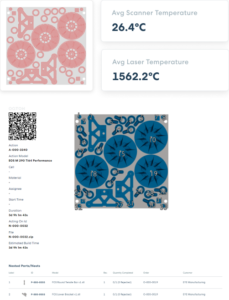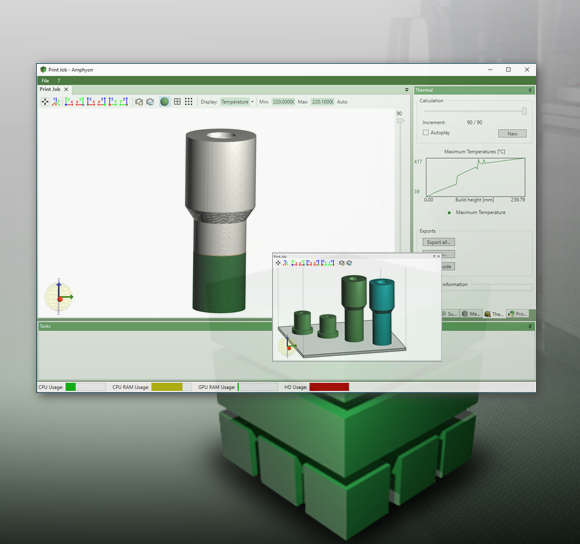Digitizing manufacturing technology is easier said than done. However, because 3D printing is already a highly digital process, it may be a prime candidate for guiding the Industry 4.0 trend. That reason, along with the great deal of enthusiasm for additive manufacturing (AM), has placed 3D printing at the center of a number of software dedicated to manufacturing execution systems (MES) that seek to weave a digital thread throughout the production workflow.
A leader in this space is Oqton, which is applying artificial intelligence (AI) to automate the entire manufacturing ecosystem. To learn more, we spoke to Ben Schrauwen, Senior Vice President and General Manager of Oqton, at IMTS.
Introducing Automation to 3D Printing
Schrauwen began by explaining that, while he worked at Autodesk, he was immersed in a trend by CAD providers to integrate design, product lifecycle management, and manufacturing software into consolidated suites. During his tenure at a large CAD developer, Schrauwen observed with interest the real-world experiences of customers in different markets. As a result, the CAD company created an all-in-one package for not just designing parts but also making them via AM, CNC, and other technologies. As much as the software firms wanted to package design and production technologies together, however, the reality on the ground proved that it wasn’t as easy as it sounded.
“When talking to customers, it became very apparent that the issues they were struggling with was that batch sizes were getting smaller all the time. The time between new product introductions always needed to be shorter. All of these very disruptive, complex production technologies—five-axis machining, metal 3D printing—were super difficult to actually use at scale. And a huge talent gap was developing. The newer generation [of engineers] are really generalists, whereas, in the olden days, when you needed to program five-axis machines, you needed people that worked on it their whole life. Or if you really wanted to leverage metal 3D printing, you needed to hire somebody with a PhD in metal 3D printing,” Schrauwen said. “There was this big divide between what all these CAD-CAM and PLM companies were doing and what customers were really experiencing themselves.”
To help address the problem, Oqton began building machine learning-based automation on top of production software, resulting in what it calls its Manufacturing OS. Unlike other MES software, the firm’s Manufacturing OS not only tracks what happens on the factory floor, but controls it. In the process, Oqton’s software can continuously suggest better ways in which items can be made.
Oqton’s Built-in Traceability
In the case of dental aligners, which rely on patient-specific 3D printed molds, the Manufacturing OS plays an integral role in enabling lights-out, automated production. Schrauwen explained that the Oqton Manufacturing OS “manages everything from scheduling to nesting to build preparation, managing the machines, tracking failures, tracking the CNC, trimming, laser marking—everything.”
By being integrated into every aspect of the production process, the Oqton Manufacturing OS offers benefits aside from AI-based automation. Specifically, it enables traceability for such highly regulated fields as medicine, aerospace/military, and oil and gas. Unlike some other MES providers, Oqton built material traceability into the core of its software because it wanted to target highly regulated industries early on. With this built-in traceability, fields that require a full accounting of a manufactured item can log into the Oqton Manufacturing OS to get a full report about a part all the way down to the sensor values and oxygen concentration thresholds used on the printer while it was being printed.
Automation Beyond 3D Printing
While Oqton has begun with AM, in part due to the early adopter mentality of its users, the company is expanding into other manufacturing technologies. It is already seeing use in CNC machining, and robotic welding.
The Oqton team highlighted an interesting case study from Van Hool, which manufactures customized trailer trucks at a rate of several hundred per year. Traditionally, the company would spend about three weeks for a highly trained robotics programmer to generate a program for the welding operations for a single truck trailer. This expertise would then have to be applied to each vehicle. However, by using Oqton’s autonomous robotic welding solution, it was possible to automate the welding paths, cutting programming time down to under two days.
“Our software automatically extracts potential weld lines, calculates collision-free robot motions, suggests welding parameters based on user-specific AI models, and finally generates the desired weld program. The only thing the manufacturing engineer needs to do is review. Wherever there are very special welds, features that might be slightly different, that’s where they put their attention and not on all the repetitive work. This level of automation also opens a whole new market for welding robots to be used for high mix low volume production.”
Vertical-specific Artificial Intelligence
To provide solutions to all the sectors it is targeting, Oqton has chosen an interesting approach. Rather than train a general AI to tackle each and every application, the company is making application-specific AI. Its machine learning for clear aligners does not have the expertise necessary to build an aerospace part and vice versa. This means that, when a customer approaches the company to implement its tools, Oqton doesn’t need to build a special solution, but can provide an application-specific software package.
“What we do is look at industry verticals that have similar parts and similar applications, and then build an AI model that works for all of the customers in the whole vertical. So, we’re going to continuously add more verticals.”
In addition to introducing more verticals, Oqton will be integrating more manufacturing equipment, as well as other types of software. This includes laboratory information management systems (LIMS), software that is used for material testing and other small-scale data tracking and scheduling in laboratory environments.
One might think that such a small-scale environment would have little use for automation software, but even in, say, a university lab, it can be useful to maintain traceability related to every researcher who uses the equipment and materials. Meanwhile, a dental studio with a single 3D printer might rely on Oqton’s Manufacturing OS for the automation alone. And the software subscription can be scaled depending on the extent that it is used so that is priced according to the size of an organization.
As Oqton continues to grow, all the software products previously offered by 3D Systems will be consolidated into a single ecosystem. This includes Geomagic Control X, which is one of the leading quality control programs on the market but has been limited as a desktop software that only generates PDF reports. In the not-too-distant future, it will be cloud-based and tie quality control in with all of the other tracked data associated with printed parts. Build prep and simulation programs 3DXpert and Amphyon are other tools that have the advantage of being integrated into the Oqton suite, along with Geomagic Design X for reverse engineering.
Some of this integration will happen sooner rather than later. For instance, 3DXpert is already tied into the ecosystem, while Geomagic is not fully connected. Meanwhile, because Oqton has been walled off from its parent company, 3D Systems, to ensure data integrity as part of their technology-neutral approach, all of the tools are available to users of any CAD software and any 3D printing technology. That way, the entire AM industry will be able to benefit from the automation and traceability being introduced by Oqton.
Though it may be among the most promising, Oqton isn’t the only player in the software automation space. It will continue to compete with Materialise, the original developer of 3D printer management technology, as well as a small, but growing number of MES providers. Altogether, these firms are helping to drive forward the Industry 4.0 concept detailed in the “Automation, Additive Manufacturing and the Factory of the Future” report from SmarTech Analysis.
Subscribe to Our Email Newsletter
Stay up-to-date on all the latest news from the 3D printing industry and receive information and offers from third party vendors.
Print Services
Upload your 3D Models and get them printed quickly and efficiently.
You May Also Like
Consolidation in AM: How 2025 Is Shaping the Industry’s New Normal
The first half of 2025 has been marked by a clear shift in the additive manufacturing (AM) industry. Companies are no longer just focused on developing new tech by themselves....
Etsy Design Rule Change Reduces Selection of 3D Printed Goods
Online marketplace Etsy has implemented a rule change requiring all 3D printed goods on the site to be original designs. The update to the site’s Creativity Standards states, ¨Items produced using...
U.S. Congress Calls Out 3D Printing in Proposal for Commercial Reserve Manufacturing Network
Last week, the U.S. House of Representatives’ Appropriations Committee moved the FY 2026 defense bill forward to the House floor. Included in the legislation is a $131 million proposal for...
Transforming From Tourist to Native: Duro CEO Michael Corr Explains Why the Company Rebuilt its PLM Software on AI
In these early innings of the AI boom, many market analysts have expressed concern that AI spend has gotten too far ahead of the technology’s proven ability to deliver significant...


































